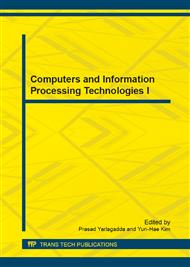[1]
Lazarsfield P et al. The People's Choice[M]. New York, Columbia University Press, (1948).
Google Scholar
[2]
Tao Wenzhao. Attach importance to Online Opinion Leaders[J]. Chinese Cadres Tribune. 2007(10): 27-29.
Google Scholar
[3]
Wang Jue, Zeng Jianping, Zhou Baohua, et al. Online Forum Opinion Leaders Discovering Method Based on Clustering Analysis[J]. Computer Engineering, 2011, 37(5): 44-46.
Google Scholar
[4]
Li F, Du T C. Who is talking? An ontology-based opinion leader identification framework for word-of-mouth marketing in online social blogs[J]. Decision Support Systems, 2011, 51(1): 190-197.
DOI: 10.1016/j.dss.2010.12.007
Google Scholar
[5]
Zhai Z, Xu H, Jia P. Identifying opinion leaders in BBS[C]/Web Intelligence and Intelligent Agent Technology, 2008. WI-IAT'08. IEEE/WIC/ACM International Conference on. IEEE, 2008, 3: 398-401.
DOI: 10.1109/wiiat.2008.37
Google Scholar
[6]
Matsumura N, Ohsawa Y, Ishizuka M. Influence diffusion model in text-based communication[J]. Transactions of the Japanese Society for Artificial Intelligence, 2002, 17: 259-267.
DOI: 10.1527/tjsai.17.259
Google Scholar
[7]
Ning Ma, Yijun Liu . SuperedgeRank algorithm and its application in identifying opinion leader of online public opinion supernetwork[J]. Expert Systems with Applications. 2014, 4(41): 1357- 1368.
DOI: 10.1016/j.eswa.2013.08.033
Google Scholar
[8]
Fan Xinghua, Zhao Jing, Fang Bingxing, et al. Influence Diffusion Probability Model and Utilizing It to Identify Network Opinion Leader[J]. Chinese Journal of Computers. 2013, 2(36): 360-367.
DOI: 10.3724/sp.j.1016.2013.00360
Google Scholar
[9]
Chen Ran. Methods and Principles about Online Forum Opinion Leaders Discovering[J]. Media Time. 2012(9): 33-36.
Google Scholar
[10]
Yu Hong. Research on the Opinion Leaders of Political BBS: An Case Study on Sino-Japan BBS of Strong Nation Forum[D]. Huazhong University of Science & Technology. (2007).
Google Scholar
[11]
Liao Hao, Li Zhishu, Wang Qiuye, et al. Text feature word selection based on relationship between words. Computer Applications. 2007, 27(12): 3009-3012.
Google Scholar
[12]
Dong Lili, Zhao Fanrong, Zhang Xiang. Sentiment analysis of product reviews based on domain ontology and sentiment lexicon[J]. Computer Applications and Software. in press.
Google Scholar
[13]
Zou Juan, Zhou Jingye, Deng Cheng, et al. A new method for synonymous processing in feature word extraction of text categorization. Journal of Chinese Information processing. 2005, 19(6): 44-49.
Google Scholar


